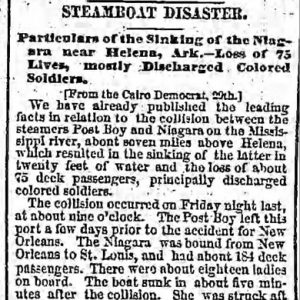calsfoundation@cals.org
Collision of Niagara and Post Boy
The steamboat Post Boy collided with the Niagara on the Mississippi River above Helena (Phillips County) on October 20, 1865, sinking the Niagara and killing seventy-five people, most of them homebound members of the United States Colored Troops.
The Niagara was a 797-ton sidewheel paddleboat built in 1864 at Cincinnati, Ohio, by Captain Henry A. Jones and his partners. By 1865, the vessel was running between St. Louis, Missouri, and New Orleans, Louisiana, for the Atlantic and Mississippi Steamship Company under Captain William Fitzgerald and clerk John Greenough.
The Niagara had a full load of cargo and people, including 250 bales of cotton and as many as 300 deck and cabin passengers, including 129 former United States Colored Troops who had recently mustered out in New Orleans, as it steamed north on the evening of October 20, 1865. As the vessel neared the mouth of the St. Francis River about seven miles north of Helena, the steamboat Post Boy, a 475-ton sidewheel paddleboat built in Pittsburgh, Pennsylvania, in 1864, was heading south. Both steamers sounded the signals required for passing boats.
As they began to pass, the Post Boy abruptly changed course and headed directly toward the Niagara; passengers on the Post Boy reported that the ship’s captain reversed engines and that pilot Preston Baxter “made every effort possible to avert the dreadful catastrophe.” Captain Fitzgerald ordered the Niagara’s engines to be shut down, but the Post Boy struck it amidships with such force that the Niagara’s engineer was able to step directly from the footboard of his engine onto the Post Boy’s deck. The Niagara began to sink rapidly.
Hearing the screams of passengers belowdecks, Fitzgerald, his officers, and some of the passengers immediately began cutting through the floor in an attempt to rescue the trapped people: “…nobly did they strive amidst that dreadful scene, at which the bravest stood appalled, as the deck was cut away, and disclosed them struggling in the water, whilst the cabin resounded with their shrieks for help,” a newspaper reported, “and only ceased when the turbulent waters had silenced every cry and closed over the lifeless bodies of those who so recently had been struggling in it. About fifty or sixty were thus saved.”
The Niagara sank to its boiler deck in twenty feet of water, and the Post Boy stayed by the wreckage, taking survivors of the disaster aboard and rescuing passengers from the water with the ship’s yawl. The steamboat Kate Hart took many of the survivors to Memphis, while the Post Boy delivered others to Helena.
Some seventy-five people died in the collision of the Niagara and Post Boy, the majority of them the recently mustered out Union soldiers. The Niagara, valued at $130,000, was not insured and was a total loss.
The sinking of the Niagara reflected the dangers of travel in the waters around Arkansas in the nineteenth century, when steamboat collisions also claimed the Gulnare in 1844, the Congress in 1846, and the Cote Joyeuse in 1847.
For additional information:
“A Card.” [New Orleans] Times-Picayune, November 30, 1865, p. 4.
“Fearful Collision—Two Hundred Lives Lost.” Leavenworth Times [Kansas], November 30, 1865, p. 1.
“Miscellaneous.” Cairo Evening Times [Illinois], November 28, 1865, p. 4.
“River Items.” Evansville Daily Journal [Indiana], November 29, 1865, p. 4.
“Steamboat Disaster.” Chicago Tribune, December 1, 1865, p. 2.
“Sinking of the Steamer Niagara/Full Particulars.” Mobile Daily Times [Alabama], November 29, 1865, p. 1.
Way, Frederick, Jr. Way’s Packet Directory. Athens: Ohio University Press, 1983.
Mark K. Christ
Central Arkansas Library System
 Civil War through Reconstruction, 1861 through 1874
Civil War through Reconstruction, 1861 through 1874 Transportation
Transportation Niagara Disaster Story
Niagara Disaster Story  Niagara Disaster Story
Niagara Disaster Story 



Comments
No comments on this entry yet.